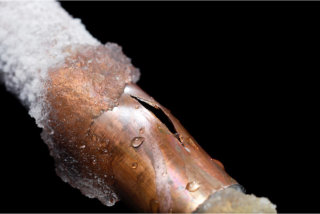The Pipes Are Calling
By Adam Bailey
Winter is coming; with it comes the risk of pipes in your home freezing, a danger that can lead to significant issues should it happen to you. As the temperatures drop, the water pipes in your home–particularly uninsulated pipes in places like exterior walls, attics and basements that don’t get as much heat from heating units–run the risk of freezing, which could just be the beginning of your troubles.
Why Frozen Pipes Are Dangerous

Frozen pipes can cause anything from a personal inconvenience to major damage to your property. The main issues you can run into include:
No Running Water – If the pipes freeze, water won’t run through them to get to the devices and appliances that require water to function. This can cause problems in completing daily tasks such as washing dishes/laundry or showering.
Possible Burst Pipes – The more serious issue to watch for is the potential for frozen pipes to burst. When a pipe freezes, the blockage and resultant back up of water causes a strain on the pipe until, after a certain amount of strain, the pipe will burst open, releasing moisture into the surrounding area and creating a perfect environment for water damage and mold growth.
 What to Look for to Identify Frozen Pipes
What to Look for to Identify Frozen Pipes
Firstly, water won’t freeze above 32 degrees Fahrenheit, so there’s no need to worry until the weather starts getting that cold or colder. Once the temperatures begin dropping below 32 degrees, however, here are three clues that might mean a pipe has frozen:
- Frost on Pipes
- No Water Coming Out of Faucets
- Strange Smells from Faucets/Drains
How to Thaw a Frozen Pipe
Before thawing a frozen pipe, turn the water off and get a mop and bucket ready in case the newly thawed pipe exposes cracks or other issues in the structure of the pipe, in the form of surprise gushes of water.
Using a space heater, heat lamp, or even a hair dryer, warm the frozen segment of pipe so that the ice eventually thaws, restoring the water’s ability to flow. Thermostatically controlled heat tape can also be used to thaw a pipe, but this could run you anywhere between $50 to $200, as opposed to a hair dryer you may already have lying around.
 What to do if the Pipe Bursts
What to do if the Pipe Bursts
So a pipe has burst? Don’t panic!
First, turn the water off. This will minimize the amount of flooding damage done to the area around the burst pipe. Next, get a plumber on board to repair the pipe that burst.
In the meantime, begin removing as much water from the area as you can, by any means at your disposal (wet/dry vac, mops, towels, anything that will effectively remove water from the area). Once you have gotten the water up, use a dehumidifier to get the area as dry as possible to avoid, among other issues, mold growth in the area near the burst pipe.
If you find that mold has already taken up residence, MoldHold is a great choice to contain the mold while you get a professional in to remediate the mold.


